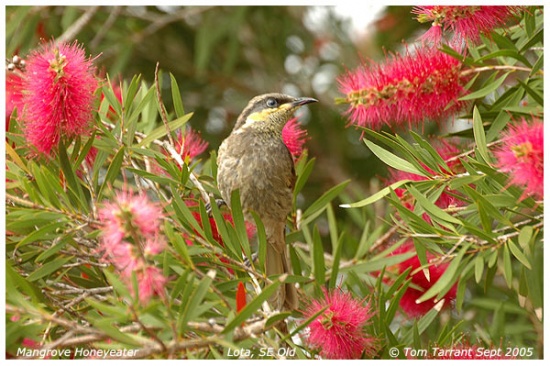| Line 3: | Line 3: | ||
==Identification== | ==Identification== | ||
Location: Lota, SE Qld | Location: Lota, SE Qld | ||
| − | + | ||
Mangrove Honeyeaters are medium-sized honeyeaters, dark grey-brown backed with yellow edges to the wing and tail feathers and yellowish brown throat. A broad black band through the eye is bordered below by a yellow streak. The bird’s two to four note call is clear and strong and is repeated in a rollicking sequence. | Mangrove Honeyeaters are medium-sized honeyeaters, dark grey-brown backed with yellow edges to the wing and tail feathers and yellowish brown throat. A broad black band through the eye is bordered below by a yellow streak. The bird’s two to four note call is clear and strong and is repeated in a rollicking sequence. | ||
| − | + | ==Distribution== | |
| − | |||
| − | Distribution | ||
Confined to the coastal fringe and offshore islands of eastern Australia from the Townsville area, Queensland south to the NSW north coast. It is common in Queensland but rare in NSW, where a few colonies exist at scattered localities, including the Tweed, Richmond and Clarence River estuaries and Stuarts Point south of Macksville. | Confined to the coastal fringe and offshore islands of eastern Australia from the Townsville area, Queensland south to the NSW north coast. It is common in Queensland but rare in NSW, where a few colonies exist at scattered localities, including the Tweed, Richmond and Clarence River estuaries and Stuarts Point south of Macksville. | ||
| − | + | ==Taxonomy== | |
| − | + | ==Habitat== | |
| − | |||
| − | Habitat | ||
Primary habitat is mangrove forest but the species also occurs in other near-coastal forests and woodlands, including casuarina and paperbark swamp forests. | Primary habitat is mangrove forest but the species also occurs in other near-coastal forests and woodlands, including casuarina and paperbark swamp forests. | ||
It sometimes frequents adjacent shrublands and woodlands dominated by banksias and eucalypts. | It sometimes frequents adjacent shrublands and woodlands dominated by banksias and eucalypts. | ||
It sometimes visits gardens in coastal towns. | It sometimes visits gardens in coastal towns. | ||
| − | + | Clearing of old mangrove stands and adjoining forest and woodland vegetation for tourist, residential and infrastructure development are a threat to the species. | |
| − | + | ==Behaviour== | |
| − | |||
| − | |||
| − | |||
| − | |||
| − | Clearing of old mangrove stands and adjoining forest and woodland vegetation for tourist, residential and infrastructure development | ||
| − | |||
| − | |||
| − | |||
| − | |||
| − | |||
| − | |||
| − | |||
| − | |||
==External Links== | ==External Links== | ||
*[http://www.birdforum.net/pp_gallery/showgallery.php?mcats=all&what=allfields&si=Lichenostomus+fasciogularis+ View more images of Mangrove Honeyeater in the gallery] | *[http://www.birdforum.net/pp_gallery/showgallery.php?mcats=all&what=allfields&si=Lichenostomus+fasciogularis+ View more images of Mangrove Honeyeater in the gallery] | ||
[[Category:Birds]] | [[Category:Birds]] | ||
Revision as of 12:41, 5 June 2007
- Lichenostomus fasciogularis
Identification
Location: Lota, SE Qld
Mangrove Honeyeaters are medium-sized honeyeaters, dark grey-brown backed with yellow edges to the wing and tail feathers and yellowish brown throat. A broad black band through the eye is bordered below by a yellow streak. The bird’s two to four note call is clear and strong and is repeated in a rollicking sequence.
Distribution
Confined to the coastal fringe and offshore islands of eastern Australia from the Townsville area, Queensland south to the NSW north coast. It is common in Queensland but rare in NSW, where a few colonies exist at scattered localities, including the Tweed, Richmond and Clarence River estuaries and Stuarts Point south of Macksville.
Taxonomy
Habitat
Primary habitat is mangrove forest but the species also occurs in other near-coastal forests and woodlands, including casuarina and paperbark swamp forests. It sometimes frequents adjacent shrublands and woodlands dominated by banksias and eucalypts. It sometimes visits gardens in coastal towns. Clearing of old mangrove stands and adjoining forest and woodland vegetation for tourist, residential and infrastructure development are a threat to the species.




